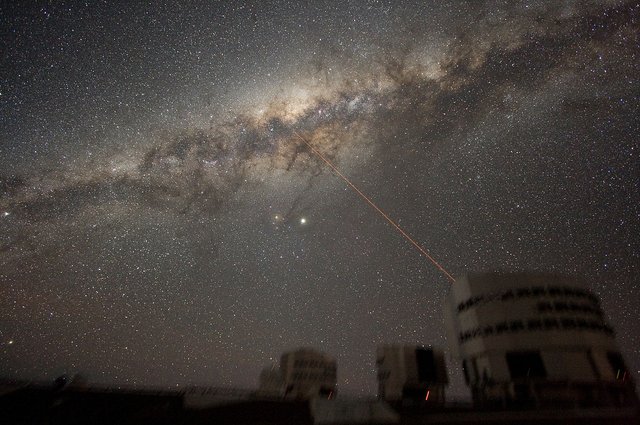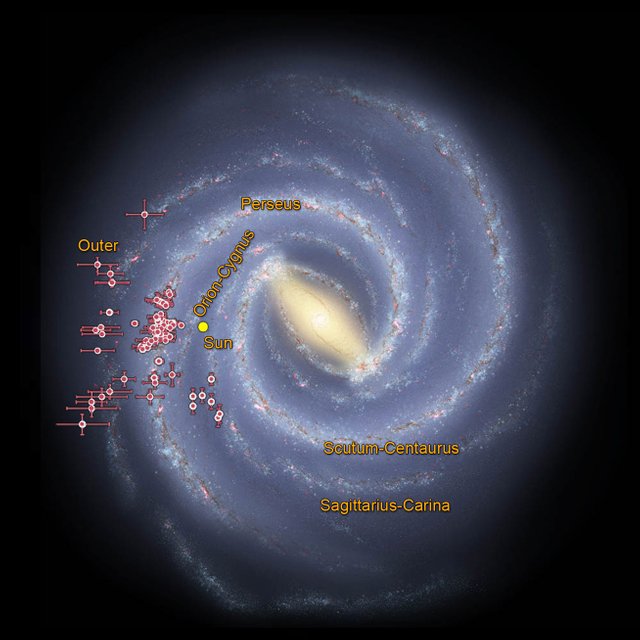Mapping the Milky Way
The Milky Way galaxy is our home, we should probably look around
Complications
Another major problem is of our location. We are inside of the milky way galaxy, which means a lot of objects will block our view. The outer edges and spirals of the Milky Way have massive amounts of dust, which is hard to see through. It is also very hard for us to see anything of the other side of the galaxy. Any light rays that do somehow make it to us are drowned out and distorted by the rest of the galaxy. This means we can not see all, or even the majority, of the galaxy. [2]
Collecting Data
We are scanning the sky in many different ways with many different projects. This produces a massive amount of data which can all be combined to fill in different areas.
WISE, or Wide-field Infrared Survey Explorer, is one such source of data. WISE took infrared pictures of the entire sky, multiple times. This is a massive amount of data and has found an estimated 750 million objects. It finished scanning the sky in 2011, but scientists are still going through the data. [3]
This data is often used for many different things. Finding NEO is one important example. Another is looking beyond our solar system. WISE data has helped us understand the shape of the spiral arm we are located in. Dust often glows in infrared and the spiral arm is made up mostly of dust clouds. [4]
The Gaia satellite has been sitting about 1.5 million miles out from Earth's orbit taking pictures of the Milky way since 2013. This telescope has found over a billion different stars. This is the biggest mapping project that has happened. [5]
The Spitzer infrared space telescope was used to figure out the general shape of our galaxy. After that it has also taken a 360 degree view of the Milky Way. This is being used to figure out where the edges of the galaxy are located.[6]
Through this we have learned enough to figure out the general shape of our galaxy and our position in it.
Astronomers disagree on the names and roles of some of these arms. Robert Hurt viewed the Milky Way as two major arms and two minor ones, although some astronomers think all 4 are major. This is due to arguments over what actually defines a major arm. They have enough matter, but seem to not produce enough stars. [7]
In the end the exact designation of the arms is not as important as how much we know about them. The Milky way is massive, and we have only mapped the general shape of the Milky way and the areas close by. Throughout the future we will hopefully learn more.


And then, there is, THE GREAT ATTRACTOR! at the center of the Milky Way. It is located at 26 degrees of Sagittarius. And, they have confirmed, it is a BLACK HOLE. I want to know more about this! Exciting!
we have known this for a long time. There is a black hole at the center of every galaxy
Yes, but not every one it the GREAT ATTRACTOR. Right?
what?
"every one it the GREAT ATTRACTOR"
great attractor is just a title, and are you calling the center black hole here one of them?
Pretty intense stuff here! I still think it's a miracle we are spinning at about 1000 miles an hour and the clouds spin with us!
"miracle" don't give flat Earthers a chance, its friction lol
eeek!
When humans cannot even map one milky way and only guessing everything, we need something faster than the speed of light to map all these things @anarchyhasnogods
"When humans cannot even map one milky way"
What? There is only one?
" and only guessing everything"
no? We are using telescopes?
"we need something faster than the speed of light to map all these things"
what? To map the Milky way all we need to do is collect light from stars so that we can figure out where they are, its just like seeing.
Good work @anarchyhasnogods
good post
Great stuff to geek out on - - thanks.
This topic is a lot like art, some people see things others don't. Major, minor matter has long been debatable. Don't just dream it, Steemit!
Congratulations @anarchyhasnogods! You have completed some achievement on Steemit and have been rewarded with new badge(s) :
Click on any badge to view your own Board of Honor on SteemitBoard.
For more information about SteemitBoard, click here
If you no longer want to receive notifications, reply to this comment with the word
STOPI played a good amount of the, now infamous, game No Man's Sky. This post, and the just barely mapped galaxy photo, harken back to that.
Although the game has numerous problems, this post highlights how true to life it is in its fundamental premise. Which is to say - there's a bojillion of everything and we have no idea what or where most of it all is.
I've heard they are planning a massive update to no mans sky
There have been a couple already - and I'm sure more to come. Unfortunately for me - or fortunately I suppose - I have sworn off all video games and related media as it was taking up literally all of my free time without a single thing to show for it.
Can you guess which compulsive online activity I have replaced video games with? ;)
no, I need a hint.
Rhymes with redeem tit
Edit: sort of...
Definitely worth an upvoted and a resteem :)
Despite how accurate we think we have mapped the Milky Way, it could still look somewhat different. Nice post :)